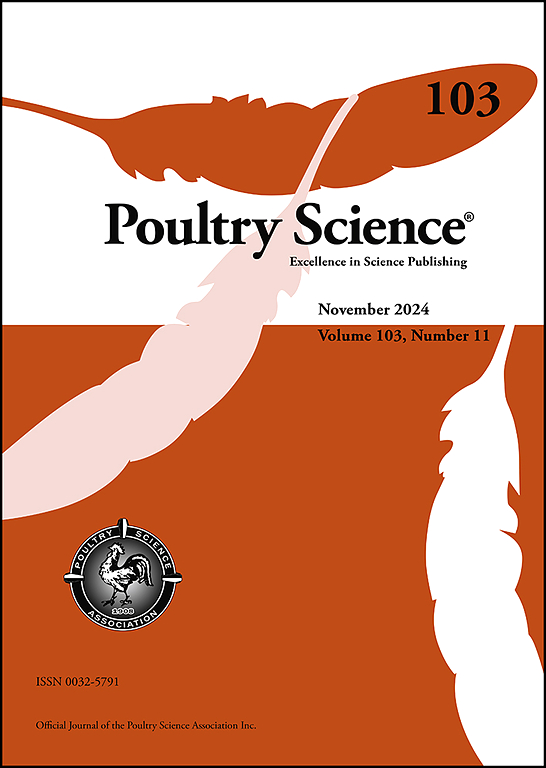Evaluating the effects of dietary glutamine on performance, carcass traits, blood biochemistry, and intestine morphology in laying quail
IF 3.8
1区 农林科学
Q1 AGRICULTURE, DAIRY & ANIMAL SCIENCE
引用次数: 0
Abstract
This study investigated the effects of dietary glutamine (Gln) supplementation on the performance, carcass characteristics, blood biochemistry, intestinal morphology, and gut microbiota of laying quail over a 12-week period, with analyses conducted after 6 and 12 weeks of supplementation. Seven-week-old dual-purpose female quails at the onset of laying were assigned to diets containing 0% (control), 0.5%, 1%, or 1.5% Gln. Performance metrics included laying rate, daily feed intake, and feed efficiency. Supplementation with 0.5% Gln significantly enhanced the laying rate after 12 weeks; daily feed intake and feed efficiency varied over time but were not consistently affected by Gln. Breast muscle weight was highest in quail supplemented with 1.5% Gln after 6 weeks. Blood serum analyses showed that total protein and albumin concentrations were highest in quail receiving 0% and 1% Gln after 12 weeks, while supplementation with 0.5% Gln decreased triacylglycerol levels after 12 weeks. Glucose and creatinine levels varied with Gln supplementation and between the two time points; enzyme activities (alanine transaminase, alkaline phosphatase, and gamma-glutamyl transpeptidase) were affected by both Gln dose and length of supplementation. Intestinal morphology was significantly influenced by Gln dose and supplementation period. The longest villi were observed in quail supplemented with 1% Gln after 6 weeks, decreasing by 12 weeks. The widest villi were recorded in quail receiving 1.5% Gln after 6 weeks, with villus width decreasing over time. Crypt depth varied significantly, with the deepest crypts observed at 6 weeks in quail supplemented with 1% and 1.5% Gln, becoming shallower after 12 weeks. Microbial analysis of digesta samples revealed Lactobacillaceae as the predominant bacterial family, followed by Enterobacteriaceae and genera including Streptococcus and Staphylococcus. Overall, dietary Gln supplementation influenced performance, carcass characteristics, blood biochemical parameters, intestinal morphology, and gut microbiota composition in laying quail, with effects varying between 6 and 12 weeks of supplementation. These findings suggest that Gln supplementation has the potential to enhance quail performance and health over time.
求助全文
约1分钟内获得全文
求助全文
来源期刊

Poultry Science
农林科学-奶制品与动物科学
CiteScore
7.60
自引率
15.90%
发文量
0
审稿时长
94 days
期刊介绍:
First self-published in 1921, Poultry Science is an internationally renowned monthly journal, known as the authoritative source for a broad range of poultry information and high-caliber research. The journal plays a pivotal role in the dissemination of preeminent poultry-related knowledge across all disciplines. As of January 2020, Poultry Science will become an Open Access journal with no subscription charges, meaning authors who publish here can make their research immediately, permanently, and freely accessible worldwide while retaining copyright to their work. Papers submitted for publication after October 1, 2019 will be published as Open Access papers.
An international journal, Poultry Science publishes original papers, research notes, symposium papers, and reviews of basic science as applied to poultry. This authoritative source of poultry information is consistently ranked by ISI Impact Factor as one of the top 10 agriculture, dairy and animal science journals to deliver high-caliber research. Currently it is the highest-ranked (by Impact Factor and Eigenfactor) journal dedicated to publishing poultry research. Subject areas include breeding, genetics, education, production, management, environment, health, behavior, welfare, immunology, molecular biology, metabolism, nutrition, physiology, reproduction, processing, and products.
 求助内容:
求助内容: 应助结果提醒方式:
应助结果提醒方式:


